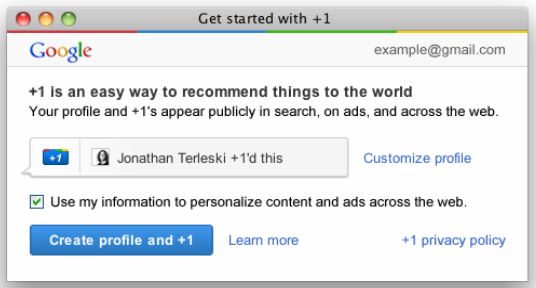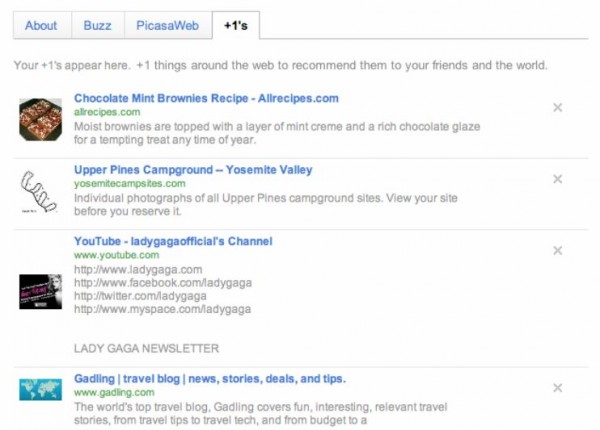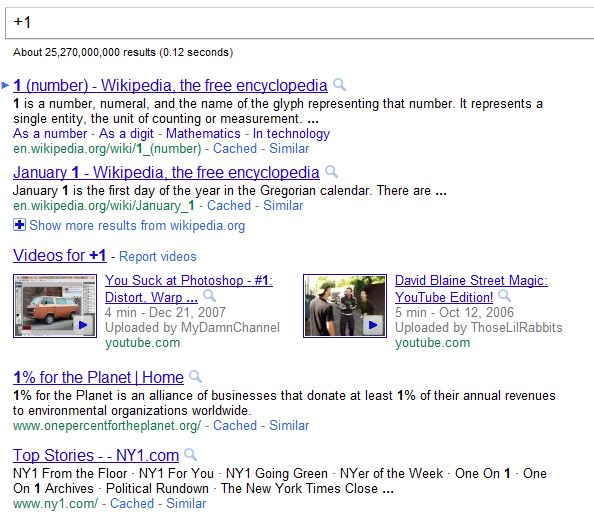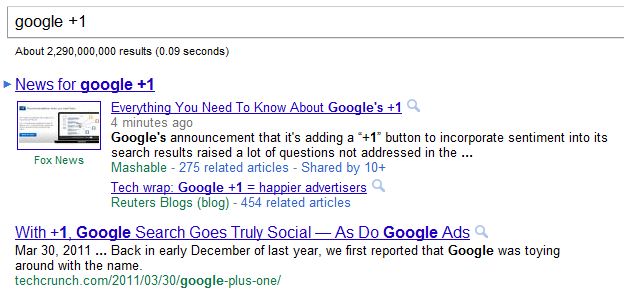Meet +1: Google’s Answer To The Facebook Like Button
Nearly a year after Facebook Like buttons spread out across the web, Google has announced its own rival, the +1 button. It launches today as part of Google’s search engine, allowing you to “+1” the search results and ads that you like. And in a few months, it’ll be arriving at a web site near […]
 Nearly a year after Facebook Like buttons spread out across the web, Google has announced its own rival, the +1 button. It launches today as part of Google’s search engine, allowing you to “+1” the search results and ads that you like. And in a few months, it’ll be arriving at a web site near you.
Nearly a year after Facebook Like buttons spread out across the web, Google has announced its own rival, the +1 button. It launches today as part of Google’s search engine, allowing you to “+1” the search results and ads that you like. And in a few months, it’ll be arriving at a web site near you.
Is +1 (pronounced “Plus One”) part of the new social network that Google’s long been rumored to be building? Or is +1 simply that “social layer” that Google has said would come and isn’t really meant as a rival to Facebook?
Yes.
Come along — let’s see how it works now, where it might go, and we’ll get into the bigger picture stuff at the end.
+1 Your Favorite Google Search Results
Beginning today, a small percentage of Google search users on Google.com in the United States searching in English will now see a +1 button next to search listings, when they are logged in. An example of this is shown below:
Don’t see it? Don’t panic. Unlike the iPad 2, +1 buttons are in plentiful supply. Just visit Google Experimental, where you can select an option to force it to appear in your searches.
Click on the button, and it lights up all colorfully:
When you’re done, you’ve “+1’d” it, as Google says, to your social network. Arguably, it might be correct to say “+1d” rather than “+1’d” — but I’ll save the Grammar Girl ruling for another time.
You’re also given an option to undo your +1ing, and you’re reminded that you’ve shared your liking of the result publicly to your social network.
There’s that mention of your social network again! Which social network? Your +1 social network, which is different than your Google Social Search network, which is different again from your Facebook network, your Twitter network and so on.
Don’t worry. I’ll get back to all this.
+1 Results From Your Network In Search
When you do a search when logged into Google, any results that you’ve +1’d — or which have been +1’d by those in your network — will be enhanced:
In the example above, you can see how one of the results coming up in a search for “nintendo” has two names attached to it. Those are two people in the searcher’s network who have liked this particular listing, plus the searcher is told there are 16 others in their network who like it.
In addition, if a search result has gained a lot of +1s but not from people in your network, you’ll still be told the total without anyone being named. That way, you can get a sense of how popular the page might be generally with +1 users.
Improving Search Results With Recommendations
The idea makes a lot of sense. If you’re searching, it’s nice to see if there are any answers that are recommended by your friends. Indeed, it makes so much sense that Google’s already been kind of offering this already through Google Social Search for nearly two years. But now these explicit recommendations become part of that.
“The primary benefit is that search gets better. It gets better in the user interface immediately, and we’ll look at it as a potential signal to improve search quality as well. I find social search extremely useful, especially with the recent updates. This change continues the evolution of social search, and it’s a natural progression to improve the search experience,” said Matt Cutts, a Google engineer who is most known for leading Google’s search spam fighting team but who also helped launch Google Social Search in 2009.
I’ll get back to how this fits into Google Social Search further below, as well as Bing’s Facebook-powered rival to that. But for now, let’s press on with more about how the new +1 works.
+1 For AdWords
Aside from Google’s search listings, you can also favorite ads from Google AdWords that show up in search results. Just click on the +1 buttons that will now show up next to them:
As with regular search results, any +1 favoring you do will show next to those ads, if others in your social network see them. And any +1s that they do on ads will be displayed for you.
Some FAQ For Advertisers & Site Owners
At this point, I can hear some advertisers going “Whaaaaat?!” We’ll have some follow-up articles soon here on Search Engine Land that look at what advertisers think about these +1 buttons showing up next to their ads.
For its part, Google tells me that it thinks advertisers will love this, that in testing it has done, clickthrough rates on +1’d ads go up, and that the company feels it’s unlikely that people will accidentally hit the ad link (costing the advertiser money) rather than the +1 button. Some other facts from Google:
- All ads will be getting these buttons
- There’s no way for advertisers to turn them off
- Clicks on the +1 button next to ads do NOT count as a paid ad click
- Advertisers will be able to see stats about which ads are getting the most +1s
Non-advertisers feeling left out on the stat front? Hang in there. Google told me that “soon after launch,” anyone registered with Google Webmaster Central will be able to see +1 stats for their non-paid or “organic” search listings.
Coming Soon: +1 For Web Sites
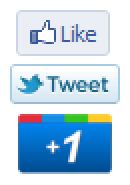
Yes, that’s right. Soon you’ll be able to add Google +1 buttons to your collection, along with Facebook’s Like buttons and Twitter’s Tweet buttons.
Google wouldn’t say much about how +1 buttons will work on web sites. For instance, if you come to a web site while logged in at Google, will you see if others in your network have +1’d a page you’re on, in the way Facebook Like buttons work?
No answer. Google is, I was told, is more focused on how +1 integrates with search right now.
Google did say that if someone does a +1 on a web page, then that will show up to others who find that page in search results. That’s going to be a huge bribe, in my view, for getting wide adoption of these buttons on web sites.
Still can’t wait? There’s a sign-up page at Google, where you can request being notified when the button is available.
Postscript: Clearly, Google does intend to personalize content on other sites. You can see this in the sign-up box below, in the Getting Started section. But Tom Critchlow also spotted how the personalization page provides more about this:
This sounds very similar to how Facebook Instant Personalization works, for the select sites that Facebook partners with, as well as how more broadly, a Facebook Like button will draw personalized content about friends from Facebook into a third-party web site.
Getting Started With +1
Ready to start +1ing things? You’ll need a Google Profile, to start. Chances are, you have one already, though you might not have pimped it out. See our previous article below for more about that:
From your profile page, you’ll need to opt-in to +1:
As I said earlier, if you don’t have this option showing automatically, visit Google Experimental, where you can make it appear for you.
After you’re enrolled, you’ll be able to manage all your +1s on a special “tab” of your profile that only you can see (unless you chose to make it public):
Now Google’s redesign of profile pages earlier this month of profile pages makes sense, eh?
Your +1 Social Network…
Let’s talk about your +1 social network now. When you enable +1, it will be made up of:
- People in your Gmail & Google Talk chat list
- People in your “My Contacts” group in Google Contacts
- People you follow in Google Reader or Google Buzz
What’s missing are people you are connected to via non-Google services, such as Twitter, Flickr or Quora. That’s something that will come in the future, Google says.
Indeed, we know that there are some “hidden” options that were added to Google Profiles recently, allowing you to connect those profiles to other social networking accounts. It could be that these will be enabled soon, as part of the +1 rollout.
Your Google Social Search Network

Google does this as part of its Google Social Search service. This combined network used to be called your “Social Circle” on Google, back when Google Social Search launched formally in January 2010 (it was an experiment before that). That launch also provided a way to view your social circle.
You can still view your social circle here on Google, but now these are called your “social connections.” I’m not sure when the name was changed, but I suspect it was dropped fairly recently, in the wake of a rumor earlier this month that Google was about to launch a “Google Circles” social network. Google’s help page still talks about your “social circle.”
All your social connections are used to help power Google Social Search results. But only your Google-based connections, right now, will power +1 matches within Social Search. Officially, Google says this is because it wants to start conservatively with +1, ramp up slowly and make sure everything works.
Google Social Search, Now With +1 Recommendations
It was just over a month ago that Google massively overhauled Google Social Search, which is a way that Google shows things that those in your social network have created or shared that are relevant to searches you do. In fact, we had a big giant article all about it:
Here’s an example of how Google Social Search works:
In that example, I did a search for “Corona del Mar bakery.” One of the pages that came up had been shared by someone I know and follow on Twitter, Amy Senk, so this was highlighted to me with a little “Amy Senk shared this on Twitter” message.
There were no buttons involved. Amy didn’t explicitly choose to recommend this page to others on her social network, via Google. Instead, Google Social Search saw she shared it through another network and used that, along with her connection to me, to highlight the page.
Now Google Social Search will gain +1 recommendations, content that people are explicitly recommending using Google’s +1 buttons. Google Social Search remains, but in addition to the first two items below, it now gains a third feature:
- Show content created by those in your social network
- Show content shared by those in your social network
- Show content recommended by those in your Google +1 network
Social search signals, including the new +1 recommendations, will also continue to influence the first two things below plus power the new, third option:
- Influence the ranking of results, causing you to see things others might not, based on your social connections
- Influence the look of results, showing names of those in your social network who created, shared or now recommend a link
- Influence the look of results, showing an aggregate number of +1s from all people, not just your social network, for some links
What Happens To Google Buzz?
Just over a year ago, Google launched Google Buzz, which initially looked to be Twitter, Facebook and Foursquare all wrapped into one. That is, it allowed for:
- Foursquare-like “check-ins”
- Facebook-like “newsfeed” of activity by friends
- Quick Twitter-like “updates”
None of this really took off. For example, consider that since the beginning of the year until now, according to figures from Google Buzz that I track:
- Mashable has gained about 100,000 Twitter followers versus about 100 Buzz followers
- TechCrunch has gained about 100,000 Twitter followers versus about 90 Buzz followers
- Robert Scoble has gained about 17,000 Twitter followers versus about 300 Buzz followers
- Search Engine Land has gained about 8,000 Twitter followers versus 51 Buzz followers
I wouldn’t say Buzz is dead, but it certainly isn’t buzzing. Any Foursquare-like pretensions seems to have been off-loaded onto the on-going location battle between Google Latitude, Google Hotpot, Google Places and Google Maps. Google itself isn’t sure which will win there, or even if there will be one winner.
Buzz does continue to provide a way to issue updates and get them from your network. But it clearly has nowhere near the activity of either Twitter or Facebook.
I suspect Buzz will be allowed to sit doing not much of anything, as +1 starts to build around in and perhaps replace it. Certainly one of the first things to go will be the Buzz buttons that you occasionally spot on the web.
Using +1 buttons is far more compelling. Those promise to increase your site’s visibility in Google’s incredibly popular search results, rather than in the little used Google Buzz area.
Finally, there’s giant irony. Earlier today, Google agreed to have its privacy controls audited over the next 20 years, in a settlement with the US Federal Trade Commission over privacy mistakes with the Google Buzz launch.
What About Google Me Or Emerald Sea?
Meanwhile, we’ve had rumor-after-rumor that Google is building a new social network beyond Google Buzz, one especially meant to challenge Facebook.
There was Google Me, said to be a full-blown Facebook challenger, in the middle of last year. By the end of the year, an internal product name of Emerald Sea started floating around. It was also rumored to be called +1. There was speculation that +1 would be the name of a new toolbar for the Google site — or a Chrome extension — or related to video conferencing.
Google’s standard response for about the past six months or so now has been to deny that it’s building a social network at all. Instead, the company has talked about adding social “layers” into everything at Google.
When I asked about the various past rumors, and how they relate to today’s launch, I got back a statement continuing the “layers” theme:
As we’ve already been saying, we’re committed to making the web more people-centric, and we’ve been gradually giving people new ways to share things and interact within our products. This is just another example of how we’re centering our products around the millions of people who use them every day.
Our focus is on improving our search results–to ensure we get the most relevant results to our users as quickly as possible. Relationships and recommendations are one way to help us achieve that goal–and this is what today’s announcement is all about.
Reading Between The Lines
Here’s the thing about Google’s claim that it’s not building a rival social network. When rumors started emerging about Google Checkout, Google made similar claims about how it wasn’t some type of PayPal rival. It was.
Google might have convinced itself it’s not building a social network, but +1 certainly seems to be a good start toward one. While it is beginning as a “layer” that’s part of search, those +1 buttons — when they hit the web — will put Google directly alongside Facebook in the “liking” game.
All the excitement that some had — and still have — about how Facebook’s Like buttons were going to give the company amazing insight about the web? Now Google’s on track to potentially get the same.
The New PageRank?

In contrast, Google’s toolbar data alone gives it insight into how much people “like” particular pages just by measuring time on site. It can also measure things like bounce rate from its search results to sites, and counting links to measure popularity still isn’t dead. These are just some of the tools Google has.
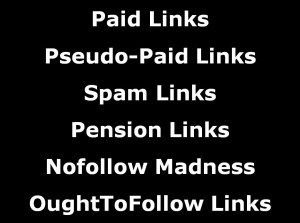
If links were like votes originally, then likes are also votes — but more trusted ones, especially when they are heavily used within someone’s specific social network (friends don’t generally spam friends).
In short, +1 becomes the new PageRank. OK, that’s kind of catchy, but more accurately, +1 recommendations can become an important new signal for Google to use as part of its overall ranking algorithm, during a time when it desperately needs new signals.
Calling For New Ranking Signals
By the way, the image just above was from my keynote talk at our recent SMX West search marketing conference, which covered the unprecedented changes we’re going through now, as search engines seek better ranking signals.
I’ll write up my keynote as an article in the near future, but you can watch the video of it below:
[youtube width=”600″ height=”480″]https://www.youtube.com/watch?v=TSZTtvgpqWw[/youtube]
We’ll also be getting back to this topic during our SMX Advanced Seattle event on June 7 and 8, as part of our The New Periodic Table Of SEO session. So come on out (and book early if so, as tickets sold out a month prior to the event last year).
Facebook Versus Google
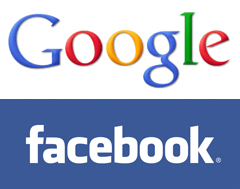
Google has been especially hobbled in that Facebook is unwilling to let people export their contacts directly to Google. Meanwhile, Google keeps saying that there’s something in Facebook’s terms and conditions that prevent it from using Facebook Connect to link to Facebook’s social data in the way that even tiny Blekko does.
That something, as best I can tell, is that Google doesn’t want Facebook to see inside its network, in the way that Facebook would like. But getting a straight answer from either company just doesn’t work. They remain at a standoff. The articles below have more about this:
- Facebook On Social Search: ‘We Want To Work With Everybody’
- Google & Facebook: If You’re So Smart, Work It Out!
+1 Won’t Kill Facebook
What’s +1 mean for Facebook? A very good chance that Facebook’s seeming monopoly on how people “like” pages will be over. Facebook’s Like buttons have a big bribe. Get liked and potentially get substantial traffic from Facebook. Speaking of which, here are some tips on that from us, below:
- How To Put The Facebook “Like” Button On A Site
- How To Optimize For Facebook’s New ‘Like’ Functionality
- How To Convert Website Visitors To Facebook Likes
Google +1 has the same compelling bribe. Get +1s, and potentially get more search traffic from Google. Expect +1 buttons to go up right alongside Facebook buttons, all over the web. But +1 is unlikely to supplant Facebook, which is far more than just putting out Like buttons.
Facebook is a compelling destination that offers many reasons for people to stay with it, perhaps the most important being that everyone seems to be there already. Plenty of your friends are there, if you want to interact that way. And going to Google is hard, because not only doesn’t Facebook let you “export” those friends, but even if it did — the friends might not want to come over.
In the end, Google seems to be making a smart play. Rather than aiming head-on at Facebook, a tough battle, Google’s using its strongest product to cherry pick one of the things it’s probably most envious about Facebook having, recommendation data.
If +1 works, it will not only improve search quality. It might make search ads more engaging, potentially improves Google’s contextual ads and eventually may turn into a core social product that can expand in new directions.
About That Name
Earlier this month, I joked that I wanted Google to launch a “PageRank This” button for web sites. The new +1 button is kind of like that, though it has been in development well before my joke.
But seriously, +1 as a name? I’ve already seen people question how to pronounce it. Worse, how do you search for it? Some are going to search for “Plus One” and not find it, unless Google adopts that alternative spelling.
As for “+1” itself, you literally cannot search for that on Google. Seriously. Look:
Any search term that has a + symbol in front of it is a special command that tells Google to find pages that have that exact term. So the search above for +1 actually means a search for the number 1. If you want to find +1, you have to search for ++1. But that doesn’t work — Google ignores the extra + symbol.
Over on Google News, where there are tons of stories about the new service, you also won’t find them with a +1 search:
Instead, you have to search for “google +1” — which also works for regular Google search — to finally get results:
Over time, this might sort itself out. But it does feel pretty odd for a search engine to give its new search tool an unsearchable name.
Some Social Search Perspective
Google’s move today is just the latest in a long line of ways it has “socialized” its results. I’d highly recommend reading our articles below that cover other important social developments at Google. Some of them also give some perspective on how while social is useful, it alone is not a cure for improving bad results:
- Google Social Search Launches, Gives Results From Your Trusted “Social Circle”, Oct. 2009
- Google Social Search Goes Live, Adds New Features, Jan. 2010
- In The Wake Of Bing & Facebook, Google Web Search Tests Getting More Social, Oct. 2010
- Google’s Search Results Get More Social; Twitter As The New Facebook “Like”, Feb. 2011
- You Can Hate (Block) But No Longer Love (Star) Google’s Search Results, March 2011
Meanwhile over at Bing, Facebook data has been used for months to reshape its results. It was a big leap for Bing. And yet, despite results being instantly socialized through Facebook Connect, so far there’s no indication that this feature is driving huge numbers of visitors to Bing.
Don’t get me wrong. I’m glad Bing got socialized, just as Google had done before it. But the nirvana of shiny high quality search results that some predicted Facebook data in particular and social data in general would bring hasn’t really arrived, I’d say. The articles below cover more about Bing’s efforts
- Bing, Now With Extra Facebook: See What Your Friends Like & People Search Results, Oct. 2010
- Blekko, Bing & How Facebook Likes Are Changing Search, Dec. 2010
- Bing Integrates Facebook Likes Further Into Its Search Results, Feb. 2011
Still, I am noticing when social results appear on both Google and Bing, an I am increasingly finding them helpful. It’s still very early days about how social data is being used. And that leads to another article with more background on this topic:
Finally, social search is perhaps best viewed as an important part of the increasingly personalized search results that both Google and Bing are delivering. The articles below cover more about this:
- Bing Results Get Localized & Personalized
- Google’s Personalized Results: The “New Normal” That Deserves Extraordinary Attention
Postscript: See our follow-up stories:
Contributing authors are invited to create content for Search Engine Land and are chosen for their expertise and contribution to the search community. Our contributors work under the oversight of the editorial staff and contributions are checked for quality and relevance to our readers. The opinions they express are their own.
Related stories






